Melbourne Tram Museum
- Follow Melbourne Tram Museum on Twitter
- Follow Melbourne Tram Museum on Facebook
- Follow Melbourne Tram Museum on Instagram
- Follow Melbourne Tram Museum on Pinterest
- Follow Melbourne Tram Museum on Tumblr
- Subscribe to Melbourne Tram Museum's RSS feed
- Email Melbourne Tram Museum
Tramway architect: Alan G. Monsborough
During the massive expansion of Melbourne’s electric tramway system during the 1920s and 1930s, Alan Gordon Monsborough [1] was Architect of the Melbourne & Metropolitan Tramways Board. He produced a huge variety of work during his tenure, ranging from signal boxes and substations to tram depots and workshops. His distinctive architectural style has left a mark on Melbourne’s streetscapes that persists to the current day.
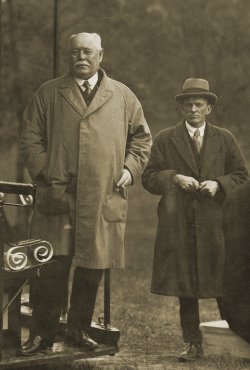 M&MTB
Chairman Alex Cameron (left) standing on a former cable tram dummy
reused as a picnic shelter at Wattle Park, with architect A.G. Monsborough,
circa 1932.
M&MTB
Chairman Alex Cameron (left) standing on a former cable tram dummy
reused as a picnic shelter at Wattle Park, with architect A.G. Monsborough,
circa 1932. - M&MTB official photograph.
Son of Alexander Edward and Mary Augusta (nee Thomas) Monsborough, he was born in Ballarat in 1888 into well-to-do circumstances, at the height of Victoria’s late nineteenth century economic boom. His father was a native of Geelong, and was well known in colonial circles as a Ballarat property owner and exceptional sporting shooter, winning the Queen’s Prize at the 1893 Victoria Rifle Association championships. Alexander Monsborough served in South Africa during the 1899-1902 Boer War in the 2nd Victorian Mounted Rifles Contingent. After his war service, he moved his family to South Africa in 1902, travelling on the White Star Line ship SS Persic II.
Alan Monsborough was educated at Grenville College Ballarat before the family’s move to South Africa, where he studied architecture at Transvaal University College from 1903 to 1906. Like his father, he was a fine rifle shot. After graduation, he worked in the Johannesburg offices of a Mr H. Seton-Morris, followed by Austin Leech.
In 1909 Monsborough joined the Architectural Department of the Johannesburg Municipal Council as a draughtsman and architectural assistant. There he contributed to the design of a wide variety of public buildings and structures, including tram depots – a sign of things to come. Active in the Baptist Church [2], he also took on private commissions for seven churches, including a particularly fine example in Troyeville, a suburb of Johannesburg, that still stands today.
He sat the special examination of the Royal Institute of British Architects in 1909, and was elected an Associate in 1911, his papers being witnessed by J.A. Hoogterp.
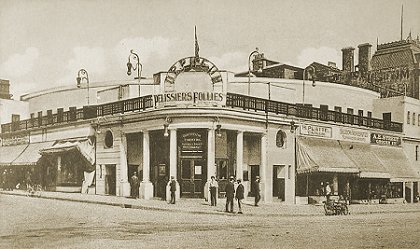 Orpheum
Theatre, Johannesburg, designed by Alan Monsborough. Constructed 1911
and demolished 1935.
Orpheum
Theatre, Johannesburg, designed by Alan Monsborough. Constructed 1911
and demolished 1935. - Photograph from an old postcard.
Other private commissions he undertook in South Africa included two large factories, a theatre, a clubhouse and two church halls. It was during this period he married Lila Ruth Dyllis Bellin in Johannesburg. She was later to become highly active in the Women’s Christian Temperance Union, and unsuccessfully stood for the Victorian State Parliament after Monsborough’s death.
Monsborough and his wife returned to Australia in 1914. It was not until the 1920s that he took up a post in the newly formed Architect’s Department of the Melbourne & Metropolitan Tramways Board, working under Ivan Dimant. On Dimant's resignation in 1926, Monsborough was appointed to his position, which he held until his sudden death on 8 April 1938. He was survived by his wife, three sons and two daughters. One of his sons was Adrian “Lazy Ade” Monsbourgh, a prominent trad jazz musician after World War II.
The access road to the Wattle Park Chalet has been named in his honour.
Architectural style
During his most productive period in the mid-1920s, Monsborough primarily used a stripped Greek Revival style well adapted to industrial settings, particularly for buildings such as tram depots and the bigger substations. His use of columns in the Camberwell Depot and Preston Workshops administration buildings is particularly evocative of Greek Revival.
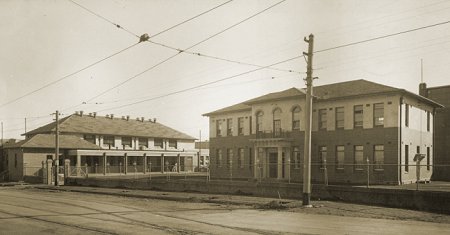 Preston Workshops – offices and mess hall, circa 1924-28.
Preston Workshops – offices and mess hall, circa 1924-28. - Official M&MTB photograph.
His most well-known building is the Chalet at Wattle Park. However, unlike his industrial buildings for the M&MTB, the Chalet was built in an English domestic style after Luytens [3], making economic use of recovered materials from demolished cable tram engine houses. This more rustic approach was well-suited to the park environment. Other Monsborough buildings in Wattle Park followed the same design motif, which he first used on the small Deepdene substation (1926), although this made restrained use of Moderne decorative brickwork.
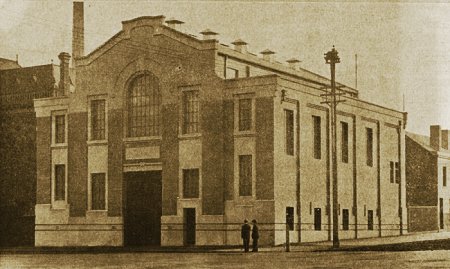 Carlton substation, 1925.
Carlton substation, 1925. - Official M&MTB photograph.
Monsborough’s town house was an impressive Victorian structure at 1 Fellows Street, Kew. However, a more bucolic environment called, and he acquired a 23 acre property at Kalorama in the Dandenong Ranges, a picturesque area not far from Melbourne. There he designed and built a holiday home in 1932, working in stone. This property was later subdivided and sold by the Monsborough family in 1940.
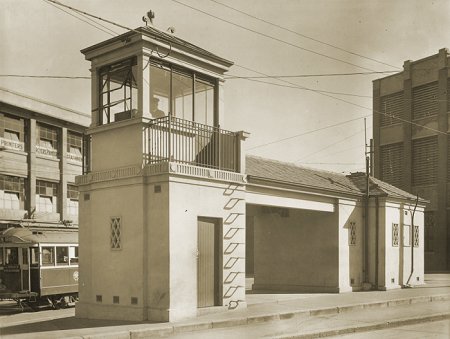 Signal box, Franklin and Swanston Streets, late 1920s.
Signal box, Franklin and Swanston Streets, late 1920s. - Official M&MTB photograph.
His last major work was the former headquarters building of the M&MTB, constructed at 616 Little Collins Street. Not completed until after his death, it is a rather subdued example of late 1930s Moderne architectural style, lacking the confidence of his earlier Greek Revival work. Erected at a cost of £57,000, it served as the headquarters of the Board until it was subsumed into the Metropolitan Transit Authority in 1983.
Not surprisingly for such a prolific architect of public buildings, much of his work has been recognised as being of lasting significance to the Melbourne built environment, and has been placed on the Victorian Heritage Register.
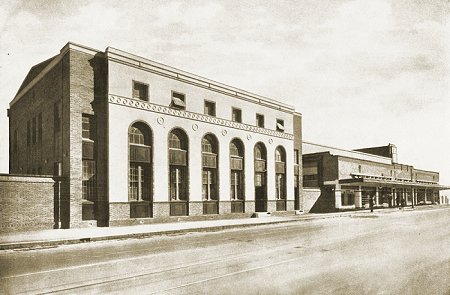 Brunswick Depot, traffic offices and shops, 1935. Note that this photograph
pre-dates the installation of overhead power lines.
Brunswick Depot, traffic offices and shops, 1935. Note that this photograph
pre-dates the installation of overhead power lines. - Official M&MTB photograph.
Buildings
Baptist Church (1911), Troyeville, Johannesburg, South Africa
Orpheum Theatre (1911), Johannesburg, South Africa (demolished 1935)
House (1912), 962 St Patrick’s Road, Houghton, Johannesburg, South
Africa
Idillio (House, 1913), 15 Campbell Road, Parktown, Johannesburg, South
Africa
Tram Depot (1924), Glenhuntly Road, Glenhuntly
Tramways Workshops (1924-28), Miller Street, Preston
Tramway Substation (1925), 53 Maribyrnong Road, Ascot Vale
Tramway Substation (1925), 30 Station Street, Camberwell
Tramway Substation (1925), 214 Queensberry Street, Carlton
Tram Depot (1925), Hanna Street (Kingsway), South Melbourne (demolished
1997)
Tramway Substation (1925), Windsor (demolished 1966)
Tramway Substation (1926), Kitchener Street, Deepdene
Tramway Signal Box (1926), Franklin and Swanston Streets, Melbourne
Tramway Substation (1927), 2 Daly Street, South Yarra
Chalet (1928), Wattle Park
Tram Shelter (1928), Wattle Park
Tram Depot – Car Barn Number 2 (1929), Coldblo Road, Malvern
Tram Depot (1930), Riversdale Road, Camberwell
Cottage (1932), Wattle Park
House (1932), Kalorama
Tram Shelter (1933), Victoria Parade and Brunswick Street, Melbourne
Tram Depot and shops (1935), Sydney Road, Brunswick
Bus Garage facade (1937), Port Melbourne (demolished)
M&MTB Headquarters Building (1938), 616 Little Collins Street, Melbourne
Note: this list of buildings designed by Monsborough is not complete.
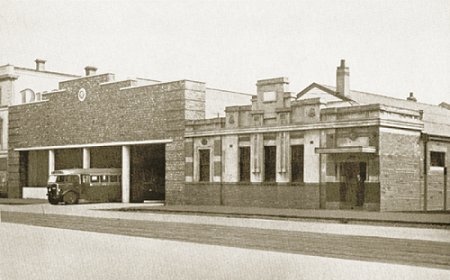 Bus Garage, Bay Street, Port Melbourne, 1937. Monsborough designed
the garage to house the buses that replaced the former cable tram
service.
Bus Garage, Bay Street, Port Melbourne, 1937. Monsborough designed
the garage to house the buses that replaced the former cable tram
service.- Official M&MTB photograph.
Bibliography
The Advertiser (1914), Affairs
in South Africa, 25 March 1914
The Argus (1893), Victorian
Rifle Association Annual Match, 25 November 1893
The Argus (1936), Bus
Depot at Port Melbourne, 17 December 1936
Artefacts.com.za, Alan
Gordon Monsbourgh
Australian Heritage Database (1993), Statement
of Significance – Wattle Park, Department of the Environment
Ballarat Courier (1914), Back
from Johannesburg – Ballarat boy’s experience, 24
March 1914
Batts, H.J. (1921), The
Story of a 100 Years,1820-1920, Being the History of the Baptist Church
in South Africa, T. Masker Miller – Standard Press Cape
Town
Boer War Nominal Rolls (1899-1902), Alexander
Edward Monsborough, Australian War Memorial
Camperdown Chronicle (1932), The
Canning of Cream, 25 June 1932
City Press (2013), Troyeville
– a suburb of spirit, 19 March 2013
The Independent (2006), ‘Lazy
Ade’ Monsbourgh, 24 August 2006
Jones, R. (2004), Fares please! An
economic history of the Melbourne & Metropolitan Tramways Board,
Melbourne Tram Museum
The Parktown and Westcliff Heritage Trust, http://www.parktown.co.za/
Public Record Office Victoria, Index
to Outward Passengers to Interstate, UK, NZ and Foreign Ports –
1852-1923
Bryce Raworth Pty Ltd (1993), Statement
of Significance –2 Daly Street South Yarra, City of Stonnington
Victorian Birth Index (1888), Births Deaths Marriages Victoria
Victorian Heritage Register, Camberwell
Tram Substation, Heritage Victoria
Victorian Heritage Register, Carlton
Tram Substation, Heritage Victoria
Victorian Heritage Register, Former
Ascot Vale Substation, Heritage Victoria
Victorian Heritage Register, Former
South Yarra Substation, Heritage Victoria
Victorian Heritage Register, Glenhuntly
Tram Depot, Heritage Victoria
Victorian Heritage Register, Malvern
Tram Depot, Heritage Victoria
Victorian Heritage Register, Preston
Tramway Workshops, Heritage Victoria
Victorian Heritage Register, Tram
Shelter, Heritage Victoria
Victorian Heritage Register, Wattle
Park, Heritage Victoria
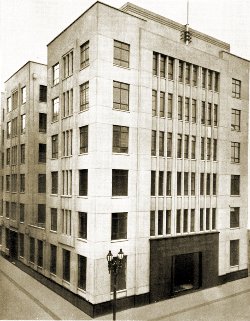 M&MTB Head Office, 616 Little Collins Street, 1937, prior to building
fit out. The building was converted to apartments in 2010.
M&MTB Head Office, 616 Little Collins Street, 1937, prior to building
fit out. The building was converted to apartments in 2010.- Official M&MTB photograph.
Footnotes
[1] There exist several variants of the spelling of both Monsborough’s surname and first name. Different sources use the spellings Monsborough, Monsbrough and Monsbourgh, while early sources tend to use the spelling ‘Allan’ and later sources ‘Alan’. The form used here is that used by contemporary sources during the period of his Australian professional life – Alan Gordon Monsborough.
[2] It was well-known that the M&MTB senior officer ranks were almost entirely Protestant, while those of the Victorian Railways were strongly inclined to Roman Catholicism.
[3] Sir Edwin Landseer Lutyens (1869-1944) was a notable British architect and town planner, primarily known for the planning of New Delhi, as well as his partnership with the garden designer Gertrude Jekyll (1843-1932).